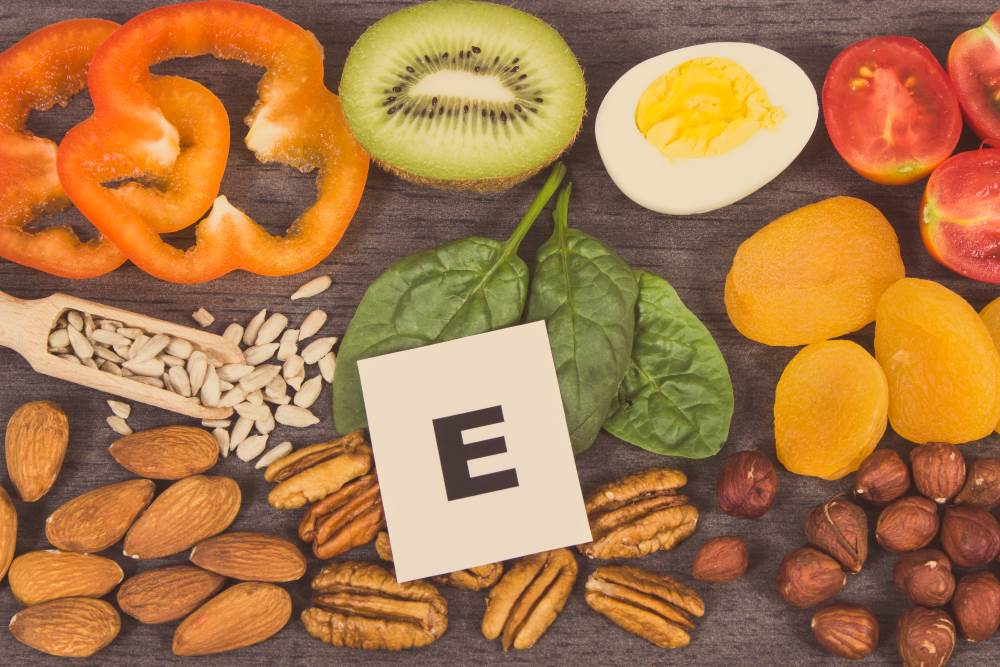15 Signs and Symptoms of Vitamin E Deficiency

Vitamin E deficiency causes neurodegeneration and fragility in red blood cells. Hence, it is imperative to have detailed knowledge about the causes and symptoms of vitamin E deficiency diseases.
Here is a detailed explanation of the symptoms and signs of vitamin E deficiency.

Table of Contents

What is Vitamin E Deficiency?
Vitamin E is an essential fat-soluble component in fruits and green vegetables. Unfortunately, the human body is incapable of producing this compound. Therefore, individuals have to consume food items rich in vitamin E to fulfil their diet requirements.
Being a fat-soluble component, vitamin E requires an adequate quantity of fat to be absorbed into the bloodstream. Typically, the human body stores vitamin E in the liver.
Though vitamin E deficiency diseases are rare, overlooking the fact can lead to serious trouble in the future.
Scientifically, vitamin E deficiency is a result of conditions that hinder the absorption or digestion of nutrients by the human body. These conditions may include diseases like cystic fibrosis, genetic disorders, Crohn's disease, liver issues, etc.
Consuming a low or no-fat diet can also lead to a deficiency of vitamin E and poor immunity. Hence, it is essential to identify the early symptoms of this deficiency and take precautions accordingly. Here are some of the common symptoms that indicate a lack of vitamin E in an individual.
How Common is Vitamin E Deficiency?
Vitamin E insufficiency is exceedingly uncommon in people since low vitamin E diets are unlikely to be the cause. Rather, abnormalities in the metabolism or absorption of dietary fat are typically the reason. Vitamin E is a vitamin that dissolves in fat.
Babies that are born preterm and have lower birth weights and less fat are likewise more likely to be deficient. Babies born before their time are especially vulnerable because a developing digestive system might make it difficult to absorb fat and vitamin E.
15 Signs and Symptoms of Vitamin E Deficiency
Some of the common symptoms of vitamin E deficiency in adults and children include
These are some of the common symptoms that indicate a vitamin E deficiency in the human body. Therefore, individuals must know how to check vitamin E deficiency to avoid the occurrence of serious diseases in the future.
Ignoring these pointers can increase the risk of major health issues in humans. Moreover, if the immunity becomes weaker, the health conditions will worsen over time. Therefore, it is suggested to get a body checkup to determine the primary causes of the deficiency.
Primary Reasons for Vitamin E Deficiency
Some of the factors that lead to vitamin E deficiency in an individual are discussed below.
Apart from diet selection, factors like genetics and medical conditions are beyond human control. These conditions can give rise to serious health issues. Hence, it is important to know which diseases are caused by the lack of vitamin E for easier diagnosis and treatment.
What are the Health Issues a Vitamin E Deficient Patient Can Suffer in Long Term?
The main side effects of vitamin E deficiency include
- Mild Hemolytic Anaemia
- Abetalipoproteinemia
- Retinopathy
- Haemorrhage in Neonates
- Chronic Cholestatic Hepatobiliary
- Cystic Fibrosis
- Spinocerebellar Ataxia
It is imperative to know what causes Vitamin E deficiency to avoid facing long term health issues. Early diagnosis would help in finding the right solution and treatment for vitamin E deficiency.
What are the Diagnosis of Vitamin E Deficiency?
Diagnosing vitamin E deficiency involves clinical assessment, laboratory tests, and sometimes additional evaluations to confirm the deficiency. Here are the methods commonly used:
Clinical Evaluation
Vitamin E deficiency can present with various symptoms, although they are not specific to this deficiency alone. Common symptoms include muscle weakness, unsteady gait, vision problems (especially retinal degeneration), and sensory changes like tingling or numbness in extremities.
Medical History
A detailed history may reveal factors predisposing individuals to vitamin E deficiency, such as malabsorption syndromes (like cystic fibrosis or celiac disease), inadequate dietary intake, or certain genetic conditions affecting vitamin E metabolism.
Laboratory Tests
Measurement of vitamin E levels in the blood (specifically alpha-tocopherol) is a common initial test. However, it's important to note that serum levels may not always accurately reflect total body stores of vitamin E, as the vitamin is primarily stored in tissues rather than circulating in high concentrations.
Red Blood Cell Hemolysis Test
This test measures the stability of red blood cells to oxidative stress induced by hydrogen peroxide. Vitamin E deficiency can lead to increased sensitivity of red blood cells to oxidative damage.
Plasma Lipid Peroxides
Elevated levels of plasma lipid peroxides can indicate increased oxidative stress due to vitamin E deficiency, as vitamin E plays a crucial role in protecting cell membranes from oxidative damage.
Genetic Testing
In rare cases, genetic testing may be necessary to diagnose specific genetic disorders affecting vitamin E metabolism, such as familial isolated vitamin E deficiency (FIVED).
Response to Vitamin E Supplementation
While not a definitive diagnostic method, improving symptoms after vitamin E supplementation can support the diagnosis. However, this method alone is inconclusive and should be interpreted with other diagnostic measures.
Differential Diagnosis
Vitamin E deficiency can present similarly to other conditions, including other nutritional deficiencies (such as vitamin B12), neurodegenerative disorders (like Friedreich's ataxia), and peripheral neuropathies. A comprehensive evaluation is important to differentiate these conditions.
Best Food Sources to Overcome Vitamin E Deficiency
Include adequate vitamin E rich foods in your diet to prevent deficiency. Below are the top foods rich in vitamin E to include in your diet
Fruits to Overcome Vitamin E Deficiency

These fruits are not only delicious but also have a high quantity of vitamin E. Pick any of these to add to your diet:
Vegetables to Overcome Vitamin E Deficiency

Below are a few vegetables to include in your diet to increase the quantity of vitamin E in your body
Other Eatables to Overcome Vitamin E Deficiency

Here are other options besides fruits or vegetables to include in your diet. Increase your vitamin E intake through these:
How Much Vitamin E Do You Need Daily?
Vitamin E intake is different among different age groups. The amount of vitamin E you need is
- 4mg a day for men
- 3mg a day for women
You should be able to get all the vitamin E you need from your diet.
Any vitamin E your body does not need immediately is stored for future use, so you do not need it in your diet every day.
Stay on Track with These Health Tools
Which Diseases are Caused Due to Vitamin E Deficiency?
Check the list below to know which diseases are caused by vitamin E deficiency and how.
How to Prevent Vitamin E Deficiency?
The standard methods of vitamin E deficiency treatment are as follows
Scientifically, the normal vitamin E level falls between 5.5 and 17 milligrams/L. However, this amount can differ for premature babies and children under 17 years. For an adult, the range must be above 4 mg/L.
Treatment and cure of vitamin E deficiency diseases can differ across human beings. Like most other nutrient deficiencies, vitamin E shortfall takes 3 weeks to 6 months to resolve. However, it is essential to follow a balanced diet to prevent the adverse effects of low vitamin E. For instance, pregnant women must consult a dietician and follow the suggestions accordingly.
Now that you have a detailed understanding of vitamin E deficiency symptoms and causes, you can start drawing your diet chart.
How Long Does it Take to Recover from Vitamin E Deficiency?
The recovery time from vitamin E deficiency can vary depending on several factors, including the severity of the deficiency, the individual's overall health, and how quickly treatment is initiated. Here’s a general overview of the recovery timeline:
Regular monitoring of vitamin E levels and clinical symptoms throughout the recovery period is essential to gauge progress and adjust treatment as needed.
Who is at Risk for Vitamin E Deficiency?
The deficiency of vitamin E may cause major harm to newborns and babies born prematurely. This is because they have lower body fat which leads to lesser absorption of lipid-soluble vitamin E. The hindrance in vitamin E absorption is more prominent in premature infants due to an underdeveloped digestive tract. This can lead to haemolytic anaemia, which destroys red blood cells.
Comparatively, adults are at a safer zone as vitamin E gets stored in the liver for immunity. However, low dietary amounts of α-tocopherol can lead to increased damage to tissues. This can lead to anaemia due to high exposure to oxygen and iron contents.
The specific groups that are particularly vulnerable to vitamin E deficiency due to various underlying factors are as follows:
Malabsorption Conditions
Conditions such as Crohn's disease, cystic fibrosis, and chronic pancreatitis can impair the absorption of dietary fats and fat-soluble vitamins like vitamin E. Individuals with these conditions may not absorb sufficient vitamin E from their diet, even if intake is adequate.
Premature Infants
Premature babies are born with lower stores of vitamin E, which normally accumulates in the last trimester of pregnancy. They are at increased risk of deficiency if not supplemented adequately, which can lead to neurological complications.
Very Low-Fat Diets
Vitamin E is primarily found in fats and oils. Diets extremely low in fats, often associated with weight-loss diets or certain medical recommendations, can lead to insufficient vitamin E intake. People adhering strictly to low-fat diets without careful planning may not consume enough vitamin E.
Genetic Disorders
Certain genetic disorders can affect the body's metabolism or transport of vitamin E. Individuals with these genetic conditions may require higher intakes of vitamin E or specialised forms of supplementation.
Older Adults
Older adults may have reduced absorption efficiency and dietary intake. Age-related changes in digestive function can lead to decreased absorption of nutrients, including vitamin E, making supplementation or dietary adjustments necessary.
Alcoholism
Chronic alcohol consumption can impair nutrient absorption and utilisation. Alcoholics may have reduced dietary intake of vitamin E and impaired liver function, which can affect the storage and metabolism of the vitamin.
Certain Medications
Some medications, such as certain cholesterol-lowering drugs (like cholestyramine), can interfere with fat absorption and affect vitamin E absorption. Individuals on these medications may require monitoring of their vitamin E status and potential supplementation.
Low-Income Populations
Socioeconomic factors can affect access to a diverse and nutritious diet. People with limited financial resources may have diets lacking in vitamin E rich foods, increasing their risk of deficiency.
Having access to a balanced diet ensures a healthy lifestyle. Although deficiency of vitamin E is rare, it is still probable. Follow the necessary instructions to ensure adequate intake of vitamin E rich food items. Consult a doctor if you need vitamin E supplementation and administer it carefully.
Protect What Matters - Explore Other Insurance Options














